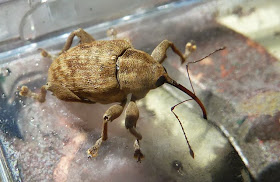 Last fall I found this long-nosed beetle in a patch of oak trees. Although it looks dangerous with a long curved snout, you should "fear no weevil," for it attacks only plants. With its long slender beak and its sharply elbowed antennae, it is identified as a nut and acorn weevil, a member of the genus Curculio with over 30 species on our continent. Many of these make their living only on oaks.
Last fall I found this long-nosed beetle in a patch of oak trees. Although it looks dangerous with a long curved snout, you should "fear no weevil," for it attacks only plants. With its long slender beak and its sharply elbowed antennae, it is identified as a nut and acorn weevil, a member of the genus Curculio with over 30 species on our continent. Many of these make their living only on oaks.
 |
| Curilio female weevil. Females have beaks longer than their bodies. |

I collected some acorns and sealed them in a ziplock bag and 24 hours later I found a Curculio larva in the bottom of the bag adjacent to a newly drilled acorn. Once out of the bag, it laid still for a minute and then started to make its getaway, looking for some nice soil to pupate for a couple of years. It was slow moving so I had lots of time to set up for this macro movie to document its progress.
 |
| Inserting the egg -click to enlarge- USFS |
Life begins for a weevil when a female bores into a green developing acorn and deposits a single egg. She seals up the tiny hole with her fecal material and the larva will emerge from the egg to find shelter and sustenance. After consuming most of the nut's contents, it carves out a round hole and struggles out of the acorn. The larva will then crawl off into the soil to pupate. The whole process is shown in this short National Geographic video.
 |
| Larva emerging from an acorn - Jay Barber |
 | ||||
| Taking off from Antlab video | |
The pupa may not emerge for over a year, coming out as an adult in the summer, hopefully at the time the acorns are greening up. After mating, the female begins a long journey up a mature oak to start the cycle again. She flies, although you would never guess it from this photograph. Watch the sequence in the first 90 seconds of slow motion here, but watch the rest for other cool insect flights.
 |
| C. halone carrying weevil - Tom Murray CC |
 |
| C. halone in the nest- Tom Murray CC |
As if life wasn't hard enough, here come the weevil wasps, Cerceris sp. that specialize on acorn weevils. Cerceris halone attacks only oak acorn weevils. The female wasp stings the weevil and paralyzes it. The immobile
weevil is then brought back to the previously prepared underground nest and stuffed inside a
cell where it remains alive, but paralyzed. A hatching wasp larva
immediately begins feeding on the living, paralyzed weevil.
Once the wasp larva has grown, it will pupate into its adult form and
leave the nest and the now dead weevil larva.
 |
| Larva in acorn - USFS |
A fun fall activity is to collect acorns and crack them open to find weevil larva. Put them in a pan of water and save the ones that float to crack open for the larva. The space that the larva has chewed out makes them buoyant. On the other hand, if the acorns sink "you will see no weevil." Sorry......no, not really.
